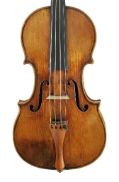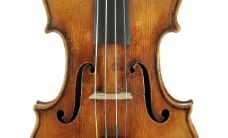Violin, Antonio Stradivari, Cremona, 1707, “ex Brüstlein”
Druckzettel: „Antonius Stradiuarius Cremonensis / Faciebat Anno 1707“ (07 handschriftlich)Stradivari built the violin now known as “ex Brüstlein” at the beginning of the period posterity refers to as his Golden Period. At this time, Stradivari had reached the acme of craftsmanship and creative power, which also brought him considerable wealth. An early biography of Stradivari recounted that the expression “as rich as Stradivari” was popular in Cremona back in the day. The contours of this instrument’s ribs correspond closely to an inner mold from Stradivari’s workshop bearing the letter “P” that is now housed at the Museo del Violino in Cremona (inventory no. MS 44). Stradivari used this inner mold dated February 25, 1705, for a large number of instruments. Apart from the “ex Brüstlein” Stradivari, the “ex Hämmerle” violin from 1709 was also built on this mold. The two-piece spruce belly is very fine grained, with the latest annual ring dated 1630. Usually, two-piece bellies show the most recent grain near the center joint. However, Stradivari joined the wood in the reverse direction on this violin, so that the youngest tree rings are at the edge. The direction of annual rings is also reversed on several other Stradivaris from this period. The master luthier may have chosen this variation, which has no acoustic impact, simply because it was aesthetic or economized on wood. The one-piece back has medium-wide flames descending slightly toward the bass side. During these years, Stradivari had especially attractive featured maple to work with. He seems to have used it also to make the backs of several other instruments from this period. The ribs as well as the pegbox and scroll of the “ex-Brüstlein” violin are fashioned from similarly flamed maple. The medium-high, full arching begins after a narrow fluting channel and exhibits very harmonious curves. The purfling, edgework and corners display the trademark degree of perfection Stradivari achieved during this period. The powerful scroll, whose chamfers had originally been picked out in black, is typical of the master luthier’s style. The light ground is covered by a lovely, orange-red color varnish that can still be detected above all on the ribs and back. This instrument takes its name from the Brüstlein family of Berlin. Johann Jacob Brüstlein and his son Carl Gustav had acquired great wealth in the 19th century as bankers.
Borrower: Yamen Saadi






